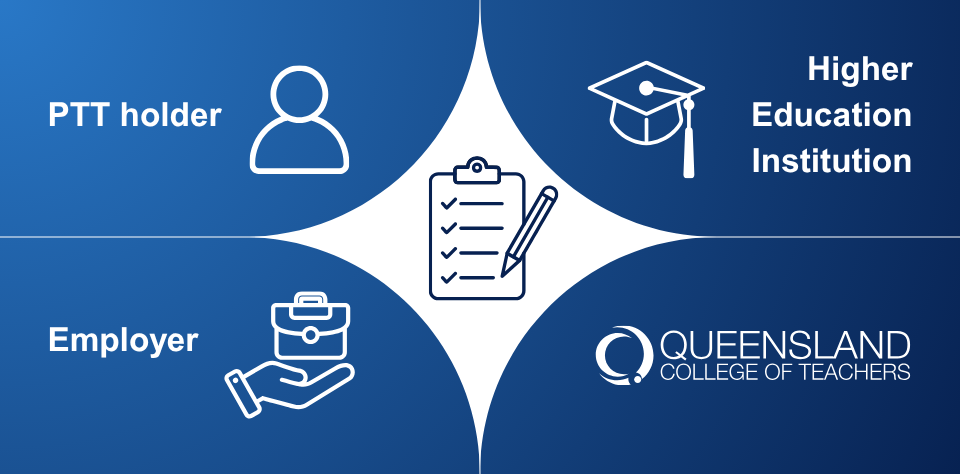Supporting preservice teachers on PTT

Preservice teachers are expected to continue their initial teacher education (ITE) studies while undertaking Permission to Teach (PTT) positions.
Their PTT experience requires support from, and collaboration between, multiple stakeholders.
Below is an overview of the key roles and responsibilities of each stakeholder in supporting PTT holders – from the initial application process to teaching in schools.
The QCT has also developed a Guide for preservice teachers on Permission to Teach in Queensland to help them navigate their teaching positions.
For more information about stakeholders’ roles and responsibilities in engaging with preservice teachers, refer to the Principles for Permission to Teach document.
PTT Holders
Application documents: Submit all required information to the QCT, including confirmation of discussions with your Higher Education Institution (HEI) about your ITE workload and study arrangements.
Compliance with your approved PTT: Adhere to the approved parameters – and any conditions – outlined in your PTT approval notice by teaching only the approved subjects and year levels listed for the period of your PTT at the nominated school.
Communication with your employer: Confirm the details of your PTT approval notice with your employer, provide accurate and timely information about any issues to your school as required, and discuss your teaching load, wage, and contract.
Communication with your HEI: Engage with your HEI about expectations in completing your ITE program and don’t undervalue its impact – your goal is to complete your ITE studies and gain provisional registration with the QCT.
Professional standards and duties: Uphold the professional standardsexpected of all teachers, and be prepared to undertake non-teaching duties as determined by your school (e.g. supervision duties and attendance at non-curricular events).
Employers (Schools and Employing Authorities)
Initiate application process: Submit all required information to the QCT, including a declaration detailing the vacant position, evidence of the recruitment process* to hire a registered teacher, and information about the PTT applicant.
* Recruitment for registered teachers needs to precede any offer of employment based on PTT approval. Recruitment advertising for teaching vacancies must target registered teachers, or teachers who will be registered at the start date of the vacancy. Advertising for PTT teachers is not accepted by the QCT.
Submission of PTT declarations:
- State schools: Please contact your Regional Office to initiate the PTT process for your school.
- Catholic schools in Rockhampton, Toowoomba, and Townsville regions: Please contact your regional Diocese to initiate the PTT process for your school.
- Catholic schools (excluding the above regions) and Independent schools: Please submit your PTT declarations through your school’s myQCT account.
Workplace induction: Familiarise the PTT holder with their timetable, as well as school policies, procedures, and expectations.
Support and mentorship: Appoint a mentor and offer support for PTT holders to fulfil their teaching responsibilities, including release time for check-ins and developing a support schedule aligning with their ongoing study (e.g. a reduced load like beginning teacher allocations and increased release time during assessment periods).
Compliance: PTT holders can only teach or assess students against an educational program within the approval period, school, subjects, and year levels outlined on their PTT approval notice - they are not permitted to undertake teaching duties beyond this notice.Working outside the parameters is a general offence under QCT legislation.
Collaboration: Work collaboratively with the PTT holder’s HEI to communicate any concerns about their performance or wellbeing, discuss teaching load, and suggest support arrangements.
Higher Education Institutions
Evaluate the PTT holder’s capacity: Clarify expectations to the PTT holder for completing the remaining components of their ITE program, including discussing that they have the capability and capacity to progress through the program while working under PTT.
Ongoing communication with the PTT holder: Provide academic support to PTT holders and confirm their professional experience placement requirements for completing the ITE program.
Liaison with schools: Collaborate with employing schools to ensure the PTT holder’s learning needs align with their ITE program requirements.
ITE program delivery: Deliver ITE programs aligning with national standards and seek advice for significant accredited program changes.
QCT
Regulation and assessment: Assess PTT applications for approval or refusal in accordance with the Education (Queensland College of Teachers) Act 2005.
Guidance and policy: Provide clear guidelines and policy information to support stakeholders in understanding and fulfilling their roles in the PTT process.
Monitoring compliance: Monitor the compliance of PTT holders and employing schools with PTT approval parameters through periodic audits.
Continuous evaluation: Continuously review the PTT process to address the diverse circumstances of schools across Queensland, in line with legislation.